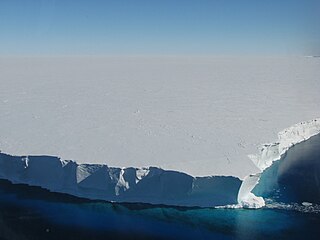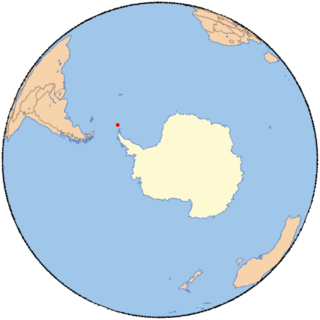Related Research Articles

The South Orkney Islands are a group of islands in the Southern Ocean, about 604 km (375 mi) north-east of the tip of the Antarctic Peninsula and 844 km (524 mi) south-west of South Georgia Island. They have a total area of about 620 km2 (240 sq mi). The islands are claimed both by Britain, and by Argentina as part of Argentine Antarctica. Under the 1959 Antarctic Treaty, sovereignty claims are held in abeyance.

Molodyozhnaya was a Soviet, then Russian research station in East Antarctica at 67°40′S 45°50′E. After being mothballed in 1990, it was reopened in 2006 to operate on a seasonal basis. In Russian, the station is sometimes referred to as the capital of Antarctica.

King Edward VII Land or King Edward VII Peninsula is a large, ice-covered peninsula which forms the northwestern extremity of Marie Byrd Land in Antarctica. The peninsula projects into the Ross Sea between Sulzberger Bay and the northeast corner of the Ross Ice Shelf, and forms part of the Ross Dependency. Edward VII Peninsula is defined by the Ross Ice Shelf on the southwest, Okuma Bay on the west, and to the east by Sulzberger Bay and the Saunders Coast, all essentially on the Ross Sea / Southern Ocean in Antarctica. The northwest extremity of the peninsula is Cape Colbeck. Edward VII Peninsula is located at 77°40′S155°00′W.

Mertz Glacier is a heavily crevassed glacier in George V Coast of East Antarctica. It is the source of a glacial prominence that historically has extended northward into the Southern Ocean, the Mertz Glacial Tongue. It is named in honor of the Swiss explorer Xavier Mertz.
The Mawson Coast is that portion of the coast of Mac. Robertson Land, Antarctica, lying between William Scoresby Bay, at 59°34′E, and Murray Monolith, at 66°54′E. The coast was sighted during the British Australian New Zealand Antarctic Research Expedition (BANZARE), 1929–30, under Sir Douglas Mawson. Further exploration and landings at Cape Bruce and Scullin Monolith were made during BANZARE, 1930–31. Mawson Coast was named by the Antarctic Names Committee of Australia after Mawson in recognition of his great contribution to Antarctic exploration.
Beaver Glacier is a glacier about 15 miles (24 km) long and 4 miles (6 km) wide, flowing west into Amundsen Bay between Auster Glacier and Mount Gleadell. The head of Beaver Glacier is located very close to the base of Mount King in Enderby Land. It was visited by an Australian National Antarctic Research Expeditions (ANARE) party on October 28, 1956, and named after the Beaver aircraft used by ANARE in coastal exploration.
The Scott Mountains are a large number of isolated peaks lying south of Amundsen Bay in Enderby Land of East Antarctica, Antarctica. Discovered on 13 January 1930 by the British Australian New Zealand Antarctic Research Expedition (BANZARE) under Sir Douglas Mawson. He named the feature Scott Range after Captain Robert Falcon Scott, Royal Navy. The term mountains is considered more appropriate because of the isolation of its individual features.
Rayner Glacier is a prominent glacier, 19 kilometres (10 nmi) wide, flowing north to the coast of Enderby Land just west of Condon Hills. It was sighted in October 1956 by Squadron Leader D. Leckie during a flight in an ANARE Beaver aircraft, and named by ANCA for J.M. Rayner, Director of the Bureau of Mineral Resources in the Australian Department of National Development.
Tange Promontory is an ice-covered peninsula just west of Casey Bay on the coast of Enderby Land in Antarctica. Kirkby Head is a sheer coastal outcrop on Tange Promontory, at the east side of the entrance to Alasheyev Bight.
Wilson Hills is a group of scattered hills, nunataks and ridges that extend NW-SE for about 110 kilometres (68 mi) between Matusevich Glacier and Pryor Glacier in Antarctica. They were discovered by Lieutenant Harry Pennell, Royal Navy, on the Terra Nova Expedition in February 1911 during Robert Falcon Scott's last expedition, and named after Edward Adrian Wilson, a zoologist with the expedition, who perished with Scott on the return journey from the South Pole.
Freeth Bay is a 5 mi wide bay on the coast of Enderby Land, Antarctica, lying 12 mi west of Spooner Bay in Alasheyev Bight. Plotted from air photos taken by Australian National Antarctic Research Expeditions (ANARE) in 1956. First visited by the Australian National Antarctic Research Expeditions (ANARE) under D.F. Styles in February 1961 and named for the Hon. Gordon Freeth, M.P., then Australian Minister for the Interior.
Spooner Bay is a 6-mile-wide bay on the coast of Enderby Land, lying 12 miles east of Freeth Bay in Alasheyev Bight. Plotted from air photos taken by Australian National Antarctic Research Expeditions (ANARE) in 1956. First visited by the Australian National Antarctic Research Expeditions (ANARE) under D.F. Styles in February 1961 and named for Sen. Bill Spooner, then Australian Minister of National Development.
Windless Bight is the prominent bight indenting the south side of Ross Island eastward of Hut Point Peninsula. Named by the Winter Journey Party, led by Wilson, of the British Antarctic Expedition (1910–13), which encountered no wind in this area.
The Douglas Islands are two small islands 22 kilometres (12 nmi) northwest of Cape Daly, and 6 kilometres (3 nmi) north of Andersen Island, as well as 7 kilometres (4 nmi) north-east of Child Rocks, which are both part of the Robinson Group. The islands lie off the coast of Mac. Robertson Land in Antarctica.
Fog Bay is a small bay immediately west-north-west of Terror Point in Windless Bight, on the south side of Ross Island, Antarctica. It was so named in July 1911 by the winter journey party, led by Edward Adrian Wilson of the British Antarctic Expedition, 1910–13, because of the thick white fog they encountered there.

Gerd Island is an island 1 nautical mile (2 km) west-southwest of Stene Point at the east side of the entrance to Norway Bight, off the south coast of Coronation Island in the South Orkney Islands. It was charted and named by Norwegian whaling captain Petter Sorlle, who made a running survey of the South Orkney Islands in 1912–13.
Kamenev Bight is a shallow embayment about 25 nautical miles (50 km) wide in the ice shelf fringing the coast of Queen Maud Land, Antarctica. Cape Krasinskiy, an ice cape, marks the western end of the bight which lies 60 nautical miles (110 km) northwest of the Schirmacher Hills. The bight was photographed from the air by the Sixth Norwegian Antarctic Expedition in 1958–59 and was mapped from these photos. It was also mapped in 1961 by the Soviet Antarctic Expedition who named it for S.S. Kamenev, an organizer of Arctic expeditions.
Rigsby Islands is a small group of ice-capped islands lying off the northeast coast of Adelaide Island, about 2 nautical miles (3.7 km) south of Sillard Islands. Mapped from air photos taken by Ronne Antarctic Research Expedition (RARE) (1947–48) and Falkland Islands and Dependencies Aerial Survey Expedition (FIDASE) (1956–57). Named by United Kingdom Antarctic Place-Names Committee (UK-APC) for George P. Rigsby, American geologist who has specialized in the investigation of ice crystal structure and the plasticity of ice.

Lever Glacier is a glacier, 1.5 nautical miles (3 km) wide at its mouth and at least 6 nautical miles (11 km) long, flowing west-northwest, then west-southwest into the head of the northern arm of Beascochea Bay north of Chorul Peninsula, on the west coast of Graham Land, Antarctica. The glacier was first sighted and roughly surveyed in 1909 by the French Antarctic Expedition. It was resurveyed in 1935 by the British Graham Land Expedition (BGLE) under John Rymill, and named in 1954 for William Lever, 2nd Viscount Leverhulme, who contributed toward the cost of the BGLE.
References
 This article incorporates public domain material from "Alasheyev Bight". Geographic Names Information System . United States Geological Survey.
This article incorporates public domain material from "Alasheyev Bight". Geographic Names Information System . United States Geological Survey.
67°30′S45°40′E / 67.500°S 45.667°E